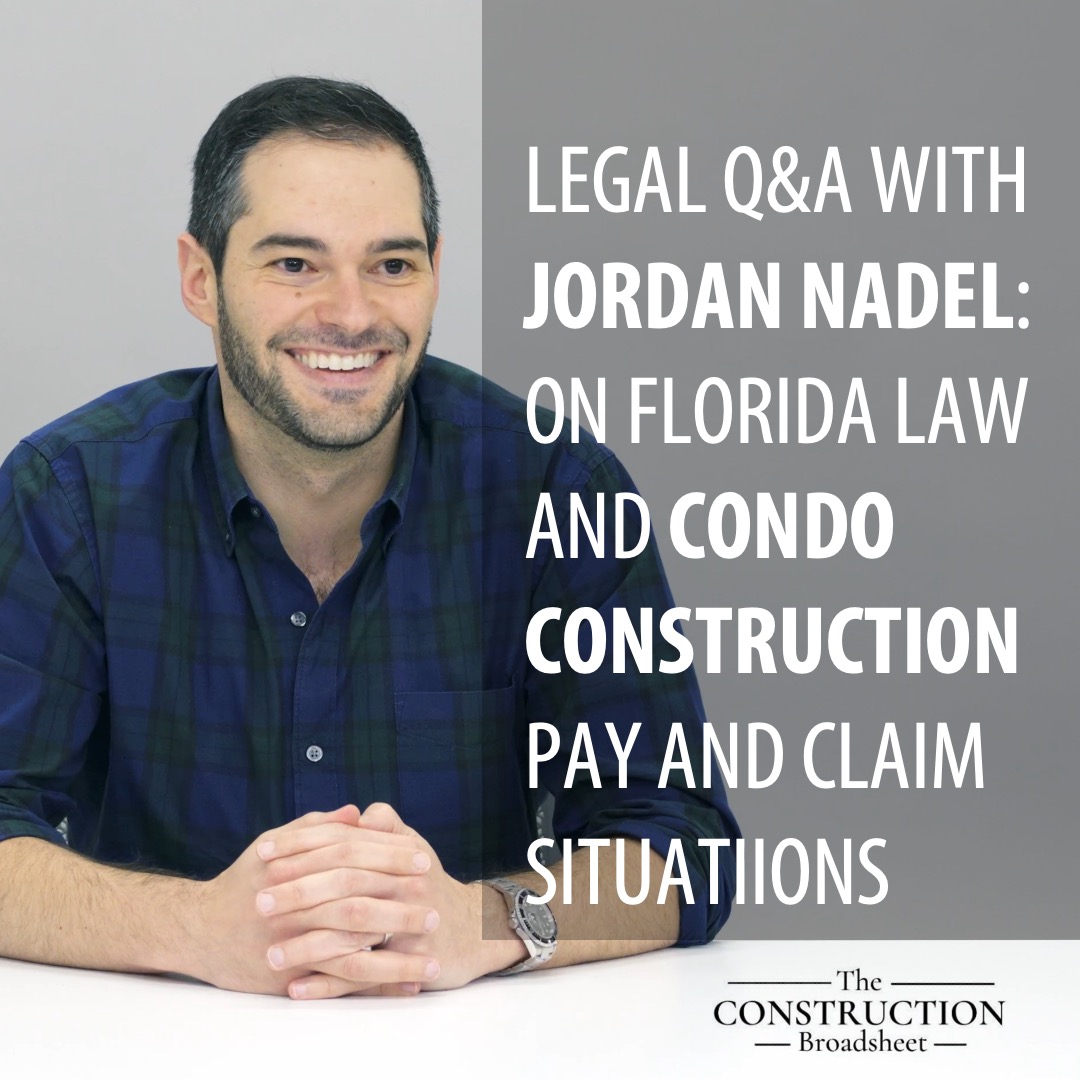Read the original article on: The Construction Broadsheet
Jordan Nadel is a commercial litigator who focuses his practice on the area of construction law. A partner and Board-Certified Construction attorney with Florida boutique litigation firm Mark Migdal & Hayden, Jordan represents clients in all aspects of the construction industry, ranging from developers, community associations, and government entities to contractors, subcontractors, and suppliers. Construction-specific issues he often handles include claims related to liens, state and federal performance and payment bonds, delays, inefficiencies, extra-contractual compensation, construction defects, and professional negligence.
Q. Our roofing firm did a reroof project for a condominium association located in Florida. They have been late paying our regular draws and have not yet paid the finally amount although the work has been approved. Are we able to go after the individual condo owners for payment?
A. If the contract is between the roofing firm and the association, the roofer will have a difficult time bringing a breach of contract lawsuit directly against the individual unit owners. However, Florida law allows a contractor to record a lien on individual units for work performed on condominium common elements. Section 718.121, Florida Statutes provides that:
Labor performed on or materials furnished to the common elements are not the basis for a lien on the common elements, but if authorized by the association, the labor or materials are deemed to be performed or furnished with the express consent of each unit owner and may be the basis for the filing of a lien against all condominium parcels in the proportions for which the owners are liable for common expenses.
As a condominium’s roofing system is generally considered part of the “common elements,” the roofer would be entitled to record a lien against each of the individual units under this language, and then initiate a lawsuit against the individual unit owners to foreclose on the lien.
In this situation, the roofer could sue the individual unit owners as a class under Rule 1.221 of the Florida Rules of Civil Procedure and name the association as a class representative. Though Florida courts have held that a plaintiff may sue a condominium association as a class representative of the unit owners without naming the individual unit owners in the lawsuit.
Additionally, to the extent specific unit owners are benefiting from the roofer’s work, the roofer may be able to assert tort-based or equitable claims against the individual unit owners.
Q. When our construction company files a Notice to Owner at the beginning of a Florida condo project for work in common areas of the complex, do we have to send a notice to each condo owner or just to our customer, the association?
A. As an initial matter, a lienor who is in direct privity with the owner does not need to serve a notice to the owner. However, assuming the prime contractor entered into a contract with an association to perform work in condominium common areas, a lower-tier party who wishes to preserve its lien rights would serve its notice to the owner of the association.
In fact, Section 713.01, Florida Statutes expressly states that the term “owner” includes “a condominium association pursuant to Chapter 718 as to improvements made to association property or common elements.”
Q. We are replacing some concrete sidewalks, a pool deck and other elements as part of a condo project in Florida, and this requires us to rope off sections of common areas for relatively short periods of time. Some residents have removed the barriers to gain access to and through these areas and, as a result, the work has been damaged. The association wants us to redo portions at our own expense, but we told them we must be paid to correct the work damaged by residents. What are our options?
A. The parties’ obligations and risk allocation is going to be determined by the language of their contract. Though in a situation, like the one above, where residents – over whom the contractor has no control – damage the work, it is very likely the contract would allow the contractor reimbursement to correct the work. There may also be negligence or other tort-based claims against the unit owners who caused the damage.
Q. We are putting in a new kitchen for a resident of a condo, and the next-door neighbor said the vibration from our work has damaged some of their items stored on the other side of a common wall and that the noise is too much. We work between the hours allowed by the condo association. How should we handle this?
A. In addition to complying with allowable work hours, the contractor should ensure that it follows any other condominium rules regarding construction at the property, notified property management of the work, and provide any requested information.
Otherwise, this is the type of situation that is well-suited to a quick resolution prior to further escalation. If the damage to the neighbor’s personal property is significant, the contractor may also consider notifying its carrier. If there are noise mitigation measures that the contractor can put in place, that may be significantly cheaper than getting drawn into time-consuming litigation concerning the neighbor’s nuisance claim.
Nevertheless, if the contractor finds itself in a situation where it is dealing with an unreasonable, unaccommodating neighbor, it may be forced to proceed with its work while the neighbor continues to raise issues or initiates litigation. In this case, the contractor should carefully document its work, ensure compliance with all applicable laws and condominium rules, and frequently communicate with property management to eliminate potential claims of wrongdoing.





